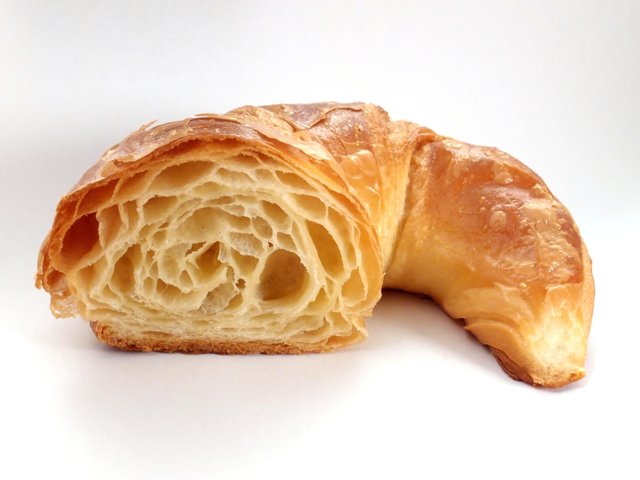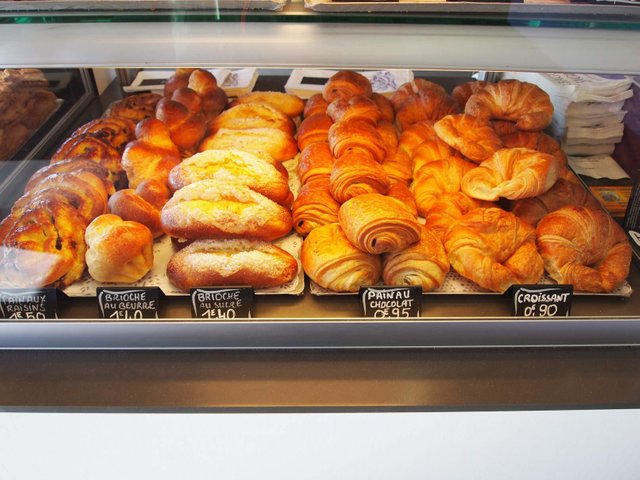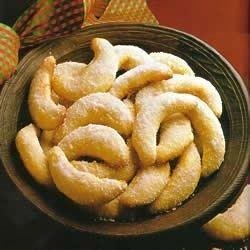The croissant

Is a buttery, flaky, viennoiserie pastry named for its well-known crescent shape. Croissants and other viennoiserie are made of a layered yeast-leavened dough. The dough is layered with butter, rolled and folded several times in succession, then rolled into a sheet, in a technique called laminating. The process results in a layered, flaky texture, similar to a puff pastry.

Crescent-shaped food breads have been made since the Renaissance, and crescent-shaped cakes possibly since antiquity.
Croissants have long been a staple of Austrian and French bakeries and pâtisseries. In the late 1970s, the development of factory-made, frozen, pre-formed but unbaked dough made them into a fast food which can be freshly baked by unskilled labor. The croissanterie was explicitly a French response to American-style fast food, and today 30–40% of the croissants sold in French bakeries and patisseries are baked from frozen dough.
Croissants are a common part of a continental breakfast in France.

Origin
The Kipferl, ancestor of the croissant, has been documented in Austria going back at least as far as the 13th century, in various shapes. The Kipferl can be made plain or with nuts or other fillings.
The birth of the croissant can be dated to at least 1839 when an Austrian artillery officer, August Zang, founded a Viennese bakery at rue de Richelieu in Paris. This bakery, which served Viennese specialities including the Kipferl and the Vienna loaf, quickly became popular and inspired French imitators. The French version of the Kipferl was named for its crescent shape and has become an identifiable shape across the world.

Zang himself returned to Austria in 1848 to become a press magnate, but the bakery remained popular for some time afterwards, and was mentioned in several works of the time.
Culinary legends
Stories of how the Kipferl and so, ultimately, the croissant was created are widespread and persistent culinary legends, going back to the 19th century. However, there are no contemporary sources for any of these stories, and an aristocratic writer, writing in 1799, does not mention the Kipferl in a long and extensive list of breakfast foods.
The legends include tales that it was invented in Europe to celebrate the defeat of the Umayyad forces by the Franks at the Battle of Tours in 732, with the shape representing the Islamic crescent; that it was invented in Buda; or, according to other sources, in Vienna in 1683 to celebrate the defeat of the Ottomans by Christian forces in the siege of the city, as a reference to the crescents on the Ottoman flags, when bakers staying up all night heard the tunneling operation and gave the alarm.
According to one of a group of similar legends, which vary only in detail, a baker of the 17th century, working through the night at a time when his city was under siege by the Turks, heard faint underground rumbling sounds which, on investigation, proved to be caused by a Turkish attempt to invade the city by tunnelling under the walls. The tunnel was blown up.
The baker asked no reward other than the exclusive right to bake crescent-shaped pastries commemorating the incident, the crescent being the symbol of Islam. He was duly rewarded in this way, and the croissant was born.
Variants
Uncooked croissant dough can also be wrapped around any praline, almond paste, jam or chocolate before it is baked (in the last case, it becomes like pain au chocolat, which has a different, non-crescent, shape), or sliced to include sweet or savoury fillings. It may be flavoured with dried fruit such as sultanas or raisins, or other fruits such as apples. In France and Spain, croissants are generally sold without filling and eaten without added butter, but sometimes with almond filling.
In the United States weet fillings or toppings are sometimes used, and warm croissants may be filled with ham and cheese, or feta cheese and spinach. In the Levant, croissants are sold plain or filled with chocolate, cheese, almonds, or zaatar. In Germany, croissants are sometimes filled with Nutella or persipan. In the German-speaking part of Switzerland, the croissant is typically called a Gipfeli; this usually has a crisper crust and is less buttery than the French-style croissant.

In Argentina, croissants are commonly served alongside coffee as a breakfast or merienda (light meal). These are referred to as half moons because of their famous shape.
In Italy, a cousin of the croissant is the Italian cornetto or brioche. These variants are often considered to be the same, but that is not completely true: the French version tends to be crispy and contains a lot of butter, whereas an Italian cornetto or brioche is usually softer. Furthermore, the cornetto vuoto (empty cornetto) is commonly accompanied by variants with filling, which include custard, apricot jam or chocolate cream. They often come covered with powdered sugar or other toppings. Cornetto with cappuccino at the bar is considered to be the most common breakfast in Italy.
In Poland, on November 11, St. Martin's Day is celebrated in Greater Poland, mainly in its capital city Poznań. On this day, the people of Poznań buy and eat considerable amounts of St. Martin's croissants". They are made specially for this occasion from puff pastry with a filling made of ground white poppy seeds, almonds, raisins, and nuts.

In Portugal, the first type of Portuguese croissant is similar to the French, and can be plain or filled with custard, chocolate, fruit jam, or a typical Portuguese cream made of egg yolk and sugar, "doce de ovo". It is customary for these to also have powdered sugar on top. The second version has a similar consistency to brioche and is commonly eaten with ham and cheese. Sometimes this type is also served like toast, with a spread of butter. While the first type of croissant is considered a sweet and is eaten during breakfast or tea, the second type is a more filling meal and is usually considered a sandwich and often prepared for picnics or as travel food.
Both types share the same name "croissant" but are typically found in different bakeries: the sweet croissant is more commonly found in Portuguese pâtisseries and the brioche croissant is usually found in coffeehouses.
In Spain, in many Spanish-speaking countries, a croissant is called a "cuerno", meaning "horn".
In Turkey, a cousin of the croissant is the Turkish ay çöreği. It is filled with cinnamon, walnut, hazelnut, cacao and raisin. Its rectangular shape variant is known as pastiç or İzmir çöreği. It is generally eaten during breakfast or with tea.

I adore all kinds of creosans
Downvoting a post can decrease pending rewards and make it less visible. Common reasons:
Submit
Since you're writing about St Martin croissants, it so happened that I have made them this weekend: https://steemit.com/food/@breadcentric/st-martin-croissant-3-rogal-swietomarcinski-3-en-pl
Wouldn't mind a link in your post ;)
Downvoting a post can decrease pending rewards and make it less visible. Common reasons:
Submit
Great Food thanks for sharing :)
Downvoting a post can decrease pending rewards and make it less visible. Common reasons:
Submit
excellent croissant
Downvoting a post can decrease pending rewards and make it less visible. Common reasons:
Submit
The croissant is looking very delicious. Thanks for delicious post.
Downvoting a post can decrease pending rewards and make it less visible. Common reasons:
Submit
really nice food.. super mind touch blog..like it..re-steem
Downvoting a post can decrease pending rewards and make it less visible. Common reasons:
Submit
AJ picked your post @lndesta120282 for his #TOP5 FOOD POST. Visit AJ's FOOD ROUNDUP to view where your post is ranked.

Downvoting a post can decrease pending rewards and make it less visible. Common reasons:
Submit
Great history............////////
Downvoting a post can decrease pending rewards and make it less visible. Common reasons:
Submit
Runs to the Panderia
Downvoting a post can decrease pending rewards and make it less visible. Common reasons:
Submit
Excellent post, I invite you to visit my blog
Downvoting a post can decrease pending rewards and make it less visible. Common reasons:
Submit
We in Algeria consider croissant a staple of breakfast and have inherited this habit from France, which was colonizing us thank you for this nice post upvoted
Downvoting a post can decrease pending rewards and make it less visible. Common reasons:
Submit
good post my friend...
Downvoting a post can decrease pending rewards and make it less visible. Common reasons:
Submit
nice post i like croissant
thanks for sharing
Downvoting a post can decrease pending rewards and make it less visible. Common reasons:
Submit
The croissant , I love breakfast with croissant always when I'm at university 😍😍😍
Downvoting a post can decrease pending rewards and make it less visible. Common reasons:
Submit
wow yummy yummy and tasty. thanks for sharing such a tasty & healthy food @indesta120282.
Downvoting a post can decrease pending rewards and make it less visible. Common reasons:
Submit
looking goooooood <3
Downvoting a post can decrease pending rewards and make it less visible. Common reasons:
Submit
wow.....that's a beautiful history..i like this food..thanks for sharing @lndesta120282
Downvoting a post can decrease pending rewards and make it less visible. Common reasons:
Submit
want some!
Downvoting a post can decrease pending rewards and make it less visible. Common reasons:
Submit
I love them and it is a must for me at least once a week :)
Great post!
Downvoting a post can decrease pending rewards and make it less visible. Common reasons:
Submit
amazing i like this food
Downvoting a post can decrease pending rewards and make it less visible. Common reasons:
Submit
Yummy!
Downvoting a post can decrease pending rewards and make it less visible. Common reasons:
Submit
delicious pastry, delicious history & delicious post.
Downvoting a post can decrease pending rewards and make it less visible. Common reasons:
Submit